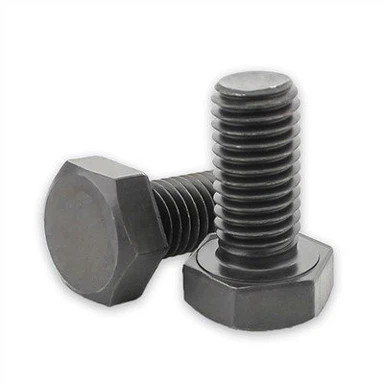Analysis Of Causes For Grayish Color in Hot-Dip Galvanized Bolts
Apr 15, 2025
Users have inquired about the grayish appearance of hot-dip galvanized bolts they previously purchased, wondering if it indicates a quality issue. Hot-dip galvanized bolts typically exhibit a matte silver-gray surface, distinct from the bright finish of electro-galvanized bolts. However, excessive grayness should be analyzed by considering process, material, and environmental factors. Below is a professional breakdown of key influences:
1. Impact of Zinc Bath Composition and Process Control
1.1 Inadequate Zinc Purity
Standard hot-dip galvanization requires zinc ingots with ≥99.99% purity (Grade 0 zinc). Adding zinc dross (containing FeZn₇ impurities), recycled zinc, or industrial waste lowers purity, causing iron content in the bath to exceed the normal limit (>0.02% vs. standard <0.003%). Excessive iron promotes the formation of coarse Fe-Zn alloy layers on the bolt surface, reducing light reflectivity and resulting in a dull gray or blackish appearance. This indicates a quality issue, often accompanied by loose zinc coating and poor adhesion.
1.2 Abnormal Bath Temperature
The optimal hot-dip galvanization temperature range is 450–480°C:
Temperatures above 490°C: Intensified oxidation produces excessive zinc oxide scum, which adheres to the bolt surface as a porous layer, leading to gray discoloration.
Temperatures below 440°C: Incomplete zinc wetting causes uneven dark spots and weak coating adhesion.
2. Influence of Bolt Material and Heat Treatment
Different bolt grades exhibit color variations due to chemical composition and heat treatment, resulting in naturally occurring color differences within acceptable ranges (using 8.8 grade bolts as a reference):
| Bolt Grade | Material Properties | Zinc Coating Formation | Color Appearance | Nature of Variation |
|---|---|---|---|---|
| 4.8 Grade | Low-carbon steel (C≤0.25%), unheat-treated, high surface activity | Rapid zinc wetting and coarse alloy layer growth | Dark gray (matte and dull) | Normal process-related effect |
| 8.8 Grade | Medium-carbon steel (C=0.25–0.55%), quenched and tempered, dense surface | Uniform alloy layer with fine crystal structure | Silver-gray (standard matte) | Typical normal state |
| 10.9 Grade | Medium-carbon alloy steel (with Mn, Cr), quenched and tempered, high surface hardness | Moderate reaction with zinc, higher proportion of pure zinc layer | Light gray (slight metallic luster) | Optimal process compatibility |
Mechanism Explanation:
4.8-grade bolts, unheat-treated, have highly reactive surfaces that form thick Fe-Zn alloy layers (Fe content 6–11%), reducing light reflectivity.
10.9-grade bolts, with hard surfaces, inhibit excessive alloying, retaining more pure zinc (Zn content >98%), thus showing higher luster.
3. Effects of Post-Treatment and Environmental Factors
3.1 Lack of Passivation Treatment
Bolts without passivation (e.g., trivalent chromium blue passivation) develop a natural zinc oxide film in air, reducing gloss by ~30% within 24 hours. This "dusty gray" appearance is a normal oxidation resistance process, not a quality defect.
3.2 Storage Environment Impact
In humid environments (humidity >60%), zinc surfaces form basic zinc carbonate white rust (initially white mist, turning grayish in severe cases). Unlike grayness from contaminated zinc baths, this rust can be mechanically removed without coating detachment.
4. Quality Assessment Standards and Recommendations
4.1 Signs of Abnormal Grayness (Quality Concerns)
Large-area dark gray patches with no metallic sheen
Powder-like residue after wiping (indicating poor coating adhesion)
Color difference >NBS 3 grade among same-batch, same-grade bolts (measured by color difference meter)
4.2 Professional Testing Methods
Zinc Coating Thickness: Magnetic thickness gauge test ≥85μm (complying with GB/T 13912 Class II standard)
Composition Analysis: X-ray fluorescence spectroscopy to verify Fe content < 0.005% in the zinc layer
Adhesion Test: Hammer test to ensure no coating peeling or bulging
4.3 Procurement Recommendations
Request furnace-specific test reports from suppliers (including coating thickness, composition, and adhesion data)
Keep standard samples for comparison to avoid misjudgment due to cross-grade color differences (e.g., 4.8 vs. 10.9 grade)
Conclusion
The primary reasons for grayish color in hot-dip galvanized bolts are:
Abnormal Grayness: Caused by contaminated zinc baths, temperature deviations, or missing post-treatment-indicates quality issues.
Natural Color Variation: Darker tones in 4.8-grade and brighter tones in 10.9 grade bolts are inherent to material-process compatibility, conforming to international standards.
Through composition analysis, thickness measurement, and adhesion testing, one can scientifically distinguish between normal color variation and quality defects, ensuring purchased products meet technical specifications.







